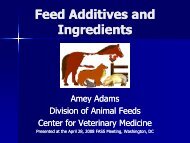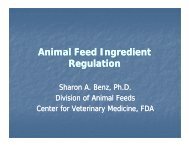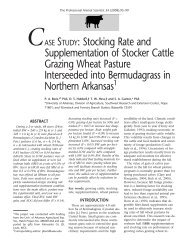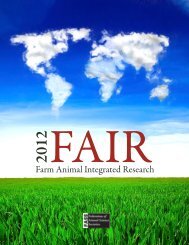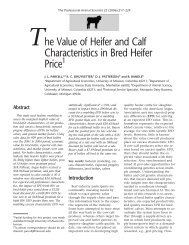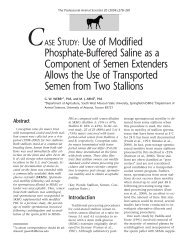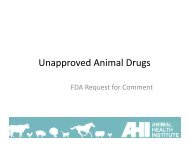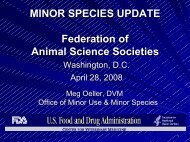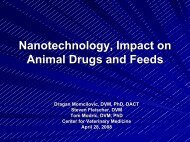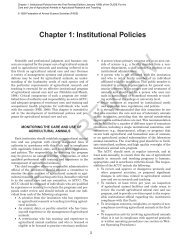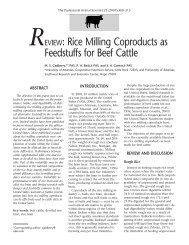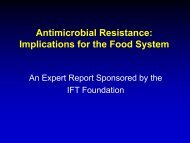Fair 2002 - Federation of Animal Science Societies
Fair 2002 - Federation of Animal Science Societies
Fair 2002 - Federation of Animal Science Societies
Create successful ePaper yourself
Turn your PDF publications into a flip-book with our unique Google optimized e-Paper software.
Protect <strong>Animal</strong> Health:<br />
Develop strategies and technologies to prevent,<br />
diagnose, and treat animal diseases<br />
C<br />
urrent and emerging food animal diseases are<br />
estimated to cause losses totaling up to 18% <strong>of</strong><br />
the annual farm gate value <strong>of</strong> animal commodities,<br />
costing producers and the U.S. economy<br />
billions <strong>of</strong> dollars each year.<br />
This represents a major threat to<br />
animal production and hurts the<br />
competitiveness and pr<strong>of</strong>itability<br />
<strong>of</strong> U.S. animal agriculture.<br />
Recent years have seen the<br />
emergence <strong>of</strong> new animal<br />
pathogens. The prevalence <strong>of</strong><br />
international travel and trade<br />
has increased the potential for<br />
accidentally or deliberately<br />
introduced foreign infectious<br />
agents that would threaten the<br />
stability <strong>of</strong> the U.S. food supply<br />
and international trade. Advances<br />
in production systems<br />
have exposed more animals to illness. Other<br />
animal diseases have re-emerged as serious<br />
threats, as previous methods <strong>of</strong> control have<br />
lost their effectiveness.<br />
To protect the health <strong>of</strong> food animals and<br />
reduce the risks that those pathogens pose to<br />
our food supply and international<br />
trade, it is imperative that improved<br />
strategies and technologies be<br />
developed to prevent, diagnose, and<br />
treat animal diseases. Research will<br />
improve the safety net for both the<br />
animals and the public.<br />
Objective 1<br />
Detect and control animal diseases that<br />
threaten the food supply<br />
Our capability to respond to an outbreak <strong>of</strong><br />
animal disease will always be dependent on our<br />
ability to diagnose the cause swiftly, which<br />
requires more rapid and accurate diagnostic tools<br />
to help producers and veterinarians appropriately<br />
treat animals and improve biosecurity.<br />
Describing the structure <strong>of</strong><br />
microbial genomes will help<br />
develop diagnostic tools and<br />
help define how disease agents<br />
infect and damage host animals.<br />
Novel treatments depend on<br />
basic insight into animal and<br />
microbial genomes.<br />
To limit effectively the spread <strong>of</strong> disease agents to<br />
animals and from animals to humans, the basic<br />
factors important in disease transmissions must<br />
be understood better. This knowledge will help to<br />
limit the transmission <strong>of</strong> diseases from wildlife to<br />
food animals, within and between farms and<br />
ranches, and from foreign countries.<br />
Objective 2<br />
Design and demonstrate production<br />
systems and management practices that<br />
reduce any adverse environmental effects<br />
<strong>of</strong> animal agriculture<br />
New technologies are needed to enhance<br />
livestock production and manure handling<br />
systems that mitigate odor and stabilize and<br />
store nutrients for transportation and use.<br />
Promising technologies include machines that<br />
bubble ozone through liquid waste to kill odorproducing<br />
bacteria and the genetic modification<br />
<strong>of</strong> feeds to increase the animal’s uptake <strong>of</strong><br />
phosphorus and reduce waste. The use <strong>of</strong><br />
beneficial microbial populations needs to be<br />
explored as a means <strong>of</strong> stabilizing nutrients<br />
and reducing ammonia and odor emission.<br />
Correctly grazing cattle and sheep on marginal<br />
lands can improve biodiversity as well as return<br />
pr<strong>of</strong>its to producers and lower costs for consumers.<br />
Developing grazing management<br />
systems that match the animals to the landscape<br />
and that promote riparian buffer strips and<br />
alternative watering systems to keep animals out<br />
<strong>of</strong> streams will allow livestock and the natural<br />
environment to flourish together.<br />
Investments in the technologies behind precision<br />
crop farming will help determine the carrying<br />
capacity <strong>of</strong> different lands and will benefit<br />
producers, land managers, and regulators as<br />
animals, watershed, and range land health are<br />
monitored and shepherded more rigorously<br />
than ever before.<br />
Objective 3<br />
Invent technologies that capture value from<br />
manure and processed by-products<br />
New technologies are needed that add value to<br />
manure and processed by-products, which will<br />
turn manure into useable bio-based fuels and<br />
other products and reduce their adverse effects<br />
on the environment. Producers and scientists<br />
already are experimenting with methanecapture<br />
systems on hog farms, and poultry<br />
producers burn methane and chicken litter<br />
to heat buildings and create electricity.<br />
Food processors and other producers <strong>of</strong> organic<br />
wastes need technologies that use their wastes<br />
and spare landfills another load <strong>of</strong> trash. Not<br />
only would they save money, turning trash<br />
into treasure <strong>of</strong>ten <strong>of</strong>fers opportunities for<br />
local entrepreneurs.



